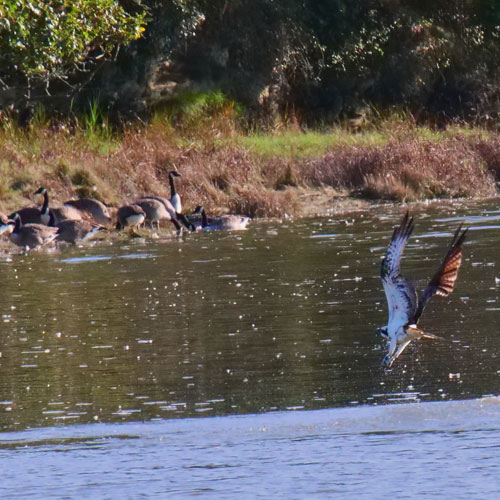Wild Roseland Nature Notes – September 2020
What a wonderful place the Roseland is for unexpected wildlife!
Imagine you are standing on Sett Bridge, the first or last bridge on the Fal river, absorbing the stunning scenery both upstream and the Fal/Ruan saltmarsh complex downstream, in early Autumn. There is a high Spring tide, which is almost full, and you are listening to plaintive Curlews or Whimbrel or watching Mute Swans or Canada Geese when suddenly your peace is shattered.
All the smaller birds, gulls, waders, and ducks fly bewildered calling into the sky and, inevitably, you wonder what caused it. They are terrified by the sight of another bird, a third bigger than a Common Buzzard, gliding high on stiff, outstretched predominantly white underwings, 6ft across. It usually comes up from the lower stretches of the river, across near Ardevora. it is generally solitary, but occasional there are two, and once I saw three. Do not expect them to always come to this spot. They also visit Devoran, Restronguet, Helford or Fowey.
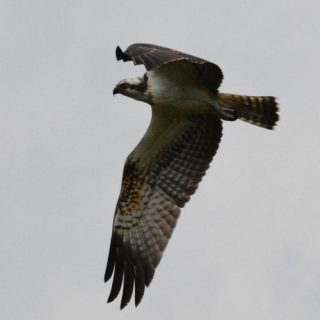 They are Ospreys! Why are they here? To fish for mullet, bass or any other large fish which is being pushed upriver at the head of the tide. Ironically, there is no need for any other birds to be “spooked” as fish is 99% of the Osprey’s diet.
They are Ospreys! Why are they here? To fish for mullet, bass or any other large fish which is being pushed upriver at the head of the tide. Ironically, there is no need for any other birds to be “spooked” as fish is 99% of the Osprey’s diet.
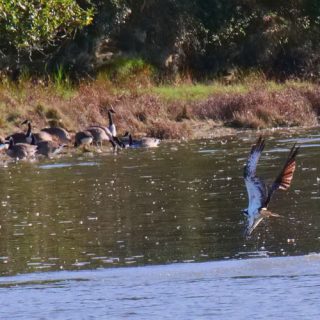 To see one prospecting is an amazing spectacle. They dive, outstretched taloned feet first, and make an almighty splash as they strike the water heavily, as they weigh 3 lbs on average. Often, like land-based fishermen, they cannot hold on to their catch. If successful, they cleverly move the fish to a forward position in their talons and fly off to a favourite feeding perch, in a dead tree somewhere out of sight.
To see one prospecting is an amazing spectacle. They dive, outstretched taloned feet first, and make an almighty splash as they strike the water heavily, as they weigh 3 lbs on average. Often, like land-based fishermen, they cannot hold on to their catch. If successful, they cleverly move the fish to a forward position in their talons and fly off to a favourite feeding perch, in a dead tree somewhere out of sight.
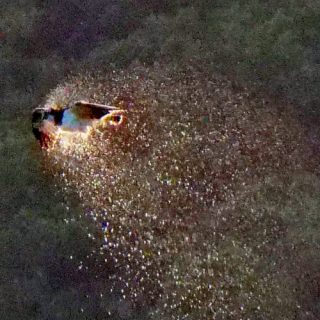 Sometimes, immature Ospreys lacking experience, will attempt fishing at lowish tides so there is always a chance you might see one at any time in Autumn, but high Spring tides are the favourite.
Sometimes, immature Ospreys lacking experience, will attempt fishing at lowish tides so there is always a chance you might see one at any time in Autumn, but high Spring tides are the favourite.
Why do we see them, from mid-August right through towards the end of October? They are migrants, so what they are doing, on the estuaries, lakes, and reservoirs of the south and west coasts of England, is fattening up for their long journeys to their wintering grounds in West Africa.
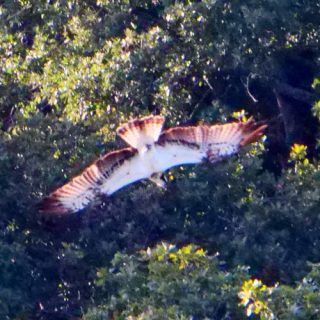 They are a success story of re-colonisation, initially in Scotland as long ago as 1954, but now also breeding in many other parts of the UK. The latest estimates show there are around 300+ pairs in the British Isles, although none here yet. I think they will breed here one day, and, indeed, occasional birds have been seen in recent years during the summer months in Cornwall, so there is always hope!
They are a success story of re-colonisation, initially in Scotland as long ago as 1954, but now also breeding in many other parts of the UK. The latest estimates show there are around 300+ pairs in the British Isles, although none here yet. I think they will breed here one day, and, indeed, occasional birds have been seen in recent years during the summer months in Cornwall, so there is always hope!
Wild Roseland is hoping to resume its programme of evening talks soon, covid protocols permitting. To date the speakers are Colin French, author of the new definitive book, “A Flora of Cornwall” which is the result of enormous work mapping, photographing, and contextualising the distribution of the rare and threatened plants of Cornwall. The Lone Kayaker, Rupert Kirkwood, will be making a popular return visit with his rather special photographs and films of wildlife seen from his kayak. Dave Cooper, Dragonfly and Damselfly Cornwall county recorder will also be giving a fascinating presentation on these incredible insects in 2021, so there is lots to look forward to.
Specific information on these events will be given, via the usual channels, once venues are confirmed as being allowable under current restrictions. The first evening meeting should be at 7.00pm on Tuesday, 29 th September,2020 (venue to be finalised,) and will be led by the Environmental Records staff from ERRCIS. This should have taken place in March 2020. It will be a practical evening workshop, “hands on” with mobile phones, on submitting records digitally. If you are interested in this and would wish to attend, please email me at hallruan@aol.com or phone 01872 501429, as no doubt social distancing will limit numbers wherever we are. Once you have registered an interest, I can keep you up to date with developments.
Roseland Podcast features the Wildflower Project.
Simon Perry’s interview with Chloe Thomas on the Roseland Podcast is well worth listening to, especially if you are thinking of having a wildflower patch in your garden or have bigger plans to create a wild flower area or meadow. Not only does he describe what Wild Roseland has been developing and encouraging, but he also provides comprehensive information on resources, contacts and projects, all of which are particularly useful. To listen to his interview visit Roseland Podcast online, or more directly , visit:
https://www.roselandpodcast.com/episode/simon-perry-from-wild-roseland-on-wild-flower-areas
The podcast is available on Apple Podcast, Spotify and all podcast apps.
Incidentally, this is the 22 nd episode in this new Roseland Podcast venture and there are many other podcasts going back to April this year, all about something of interest on the Roseland presented by local people.
But please listen to Simon’s first. It is inspiring!
Contributors:
Article by David Hall. Edited by Tara Robinson.
Wild Roseland is a group of volunteers who care passionately about looking after the nature and landscape of the Roseland peninsula in south Cornwall. Through a number of initiatives and projects, the aim is to inspire and enhance the conservation of this special place for all.
[[Usual social media links]]
Image credits:
Osprey12 by Carol Hughes
All other birds by Jane Lewarne
Wildflowers: This is the area developed by Simon Perry with the reception class of Gerrans School.

